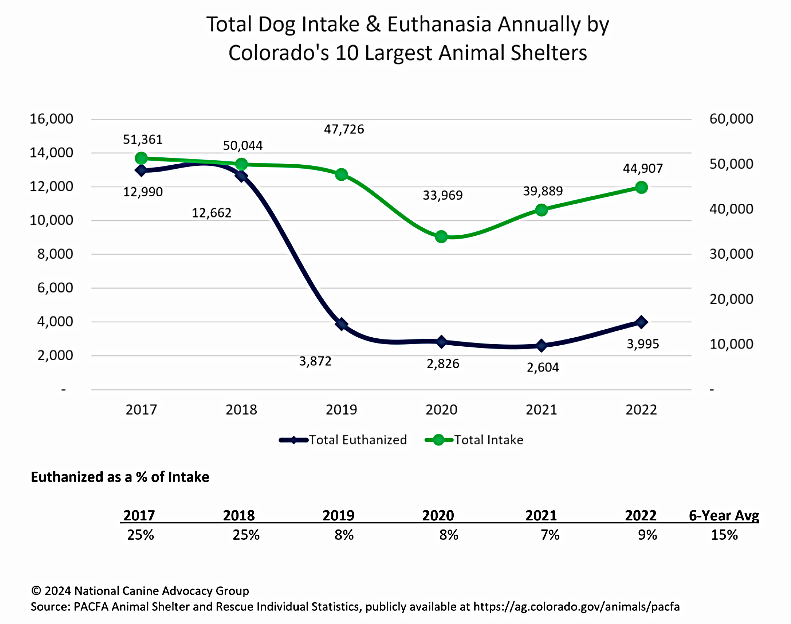

Posted on by Elizabeth Coalson
The word “euthanasia” itself comes from the Greek words “eu” (good) and “thanatos” (death). The idea is that instead of condemning someone to a slow, painful, or undignified death, euthanasia would allow the patient to experience a relatively “good death.”
We’ve said it before and will say it again, Colorado’s shelters are full, and they are struggling. In 2022, Colorado shelters took in almost 58,500 dogs, with 45,000 going into our 10 largest shelters.
These largest shelters operate under the Socially Conscious Sheltering (SCS) framework and work hard to place every healthy and safe animal. To do so is becoming more and more challenging when they’re seeing intake rates increasing in the double digits…an average of 17% in 2021 and 13% in 2022. The data for 2023 has not been published yet, but we expect to see an increase in intake at least equal to 2022, if not higher.
Many in our communities have concerns about the rate at which pet animals are euthanized, especially when more and more animals are entering our shelters, and rightly so. As our SCSs strive to ensure the best possible outcomes for every homeless cat and dog in their care and community, sometimes that best possible outcome is euthanasia. It’s not hard to imagine that, while gut-wrenching, euthanizing an animal hit by a car with multiple, irreparable injuries is the kind thing to do. One may also be able to understand the need to euthanize a dangerous animal, one who has mauled, severely injured, or even killed another animal or human. In neither of these examples does the animal have a high quality of life and it is our responsibility to humanely end their suffering. These are extraordinarily hard decisions to make and unimaginable to carry out day after day, which shelter vets and staff do.
One metric we follow to understand euthanasia trends is the number of animals, in our case dogs, euthanized by shelters as a percentage of the number of animals entering the shelters. While this number was shockingly high for the state’s 10 largest rescues in 2017 and 2018 at 25%, the rate fell to a low of 7% by 2021. For these same largest shelters, in 2022, dogs euthanized as a percentage of dog intake ticked up to 9% and we expect to see an increase when 2023 data is published. I will stop here and say a 91% save rate for dogs (the inverse of the euthanasia rate) is very high, but it is a red flag that the save rate is declining.
So, what are we to do? It all starts with keeping dogs out of shelters in the first place. Diligence around spaying and neutering is one key. Another is being 100% eyes-open and committed when adopting or buying a dog. A piece for some may be getting help when behavior becomes unmanageable. But it’s not enough that just we as the National Canine community do this…it is IMPERATIVE that we take advantage of every opportunity to educate friends, family, and our community. If you would like suggestions on how you can make a difference by educating others, please reach out, we’re happy to help!
We are also associated with Sit, Stay, Home whose mission is to keep dogs in their homes through behavior modification and obedience training. It’s important to get help BEFORE behavior becomes so problematic and frustrating that the only option seems to be to remove the dog from its home. Visit sitstayhomedogs.com to learn more.
National Canine has the most comprehensive statistics database related to Colorado animal rescues and shelters and can provide custom reports for a minimal fee. Please get in touch with us at info@canineadvocacy.org to learn more.
